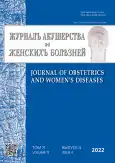Analysis of cell immune regulation features in recurrent ovarian endometriosis
- Authors: Petrovskaia N.N.1, Pechenikova V.A.1
-
Affiliations:
- North-Western State Medical University named after I.I. Mechnikov
- Issue: Vol 71, No 4 (2022)
- Pages: 53-63
- Section: Original study articles
- URL: https://journals.rcsi.science/jowd/article/view/104887
- DOI: https://doi.org/10.17816/JOWD104887
- ID: 104887
Cite item
Abstract
BACKGROUND: The prevalence of endometriosis among women of reproductive age and the complexity of choosing the methods for its effective treatment necessitate the study of the clinical and morphological features of ovarian endometriosis in its recurrent course, as well as the search for available informative diagnostic and prognostic markers which allow identifying risk groups for relapse and form prevention methods. Endometriomas have a recurrence rate of 50–55 % after treatment.
AIM: The aim of this study was to conduct a comparative analysis of cell immune regulation features in recurrent ovarian endometriosis.
MATERIALS AND METHODS: We studied clinical data, the value of peripheral immunocompetent blood cells, as well as morphological and immunohistochemical data of 196 patients operated on for endometrioid ovarian cysts, including 45 patients with a recurrent course of the disease and 151 women without relapse. Monoclonal mouse antibodies to T helpers (CD4), T killers (CD8), B lymphocytes (CD20), and macrophages (CD68) were used for immunohistochemical examination of the surgical material. Immunological examination of peripheral blood was performed by flow cytometry with the assessment of helper T lymphocyte, killer T lymphocyte and B lymphocyte subpopulations and their ratios.
RESULTS: The recurrence rate of endometrioid ovarian cysts was 22.96%. Most patients (48.87%) relapsed 3–4 years after the first operation. In patients with recurrent endometrioma, we more often detected complaints of dyspareunia, dysmenorrhea, primary infertility and a history of operations on the uterine appendages unrelated to endometriosis in anamnesis, as well as the third degree of the pathological process. During morphological examination, the glandular-cystic variant and morphologically active lesions were detected more often in recurrent endometriosis compared to the relapse-free course. Cytotoxic T killers (CD8) and macrophages (CD68) were shown to be the predominant subpopulation of cells found in the inflammatory infiltrate of cytogenic stroma and endometrioid cyst capsule. More of them were detected in recurrent endometrioid cysts in the surgical material of both the first and second operations compared to the relapse-free course. B lymphocyte count was significantly higher in the cyst capsule with recurrent endometriosis than in cases of the relapse-free course. T helpers (CD4) were found only in the surgical material of an already diagnosed recurrence. Immunological examination of peripheral blood of patients with recurrent endometrioma revealed an increase in the total population of T lymphocytes due to a subpopulation of T helpers, the number of which per microliter exceeded the reference values.
CONCLUSIONS: An increase in the number of free stromal cells in the foci of endometriosis with its recurrent course indicates the importance of hyperreactivity and the autoimmune mechanism in the chronization and progression of the disease.
Keywords
Full Text
##article.viewOnOriginalSite##About the authors
Nikol N. Petrovskaia
North-Western State Medical University named after I.I. Mechnikov
Author for correspondence.
Email: dr.ramzaeva@mail.ru
ORCID iD: 0000-0001-6849-5335
SPIN-code: 7769-1969
MD, Postgraduate student of the Department of Gynecology, obstetrician-gynecologist of the Department of Gynecology
Russian Federation, 41 Kirochnaya St., Saint Petersburg, 195015Victoria A. Pechenikova
North-Western State Medical University named after I.I. Mechnikov
Email: p-vikka@mail.ru
ORCID iD: 0000-0001-5322-708X
SPIN-code: 9603-5645
Scopus Author ID: 408079
MD, Dr. Sci. (Med.), Assistant Professor
Russian Federation, Saint PetersburgReferences
- Seo JW, Lee DY, Yoon BK, Choi D. The age-related recurrence of endometrioma after conservative surgery. Eur J Obstet Gynecol Reprod Biol. 2017;208:81−85. doi: 10.1016/j.ejogrb.2016.11.015
- Fassbender A, Overbergh L, Verdrengh E, et al. How can macroscopically normal peritoneum contribute to the pathogenesis of endometriosis? Fertil Steril. 2011;96(3):697−699. doi: 10.1016/j.fertnstert.2011.06.034
- Ouchi N, Akira S, Mine K, Ichikawa M, Takeshita T. Recurrence of ovarian endometrioma after laparoscopic excision: risk factors and prevention. J Obstet Gynaecol Res. 2014;40(1):230−236. doi: 10.1111/jog.12164
- Nirgianakis K, Ma L, McKinnon B, Mueller MD. Recurrence patterns after surgery in patients with different endometriosis subtypes: a long-term hospital-based cohort study. J Clin Med. 2020;9(2):496. doi: 10.3390/jcm9020496
- Guo SW. Recurrence of endometriosis and its control. Hum Reprod Update. 2009;15(4):441-461. doi: 10.1093/humupd/dmp007
- Kachalina TS, Bogatova ME, Kuznetsov SS, Lazukin VF. Risk factors for recurrence of ovarian endometriomas after surgical treatment: retrospective cohort study. Sechenov Medical Journal. 2020;11(4):60–71. doi: 10.47093/2218-7332.2020.11.4.60-71. (In Russ.)
- Berker B, Seval M. Problems with the diagnosis of endometriosis. Womens Health (Lond). 2015;11(5):597−601. doi: 10.2217/whe.15.44
- Tobiume T, Kotani Y, Takaya H, et al. Determinant factors of postoperative recurrence of endometriosis: difference between endometrioma and pain. Eur J Obstet Gynecol Reprod Biol. 2016;205:54−59. doi: 10.1016/j.ejogrb.2016.07.516
- Guzel AI, Topcu HO, Ekilinc S, et al. Recurrence factors in women underwent laparoscopic surgery for endometrioma. Minerva Chir. 2014;69(5):277−282.
- Pechenikova VA. Klinika, morfofunktsional’naya kharakteristika yego adenomioza i opukholevoy transformatsii. [dissertation]. Saint Petersburg; 2005. (In Russ.). [cited 2022 Feb 14]. Available from: https://www.dissercat.com/content/endometrioidnaya-bolezn-voprosy-patogeneza-kliniki-diagnostiki-i-lecheniya
- Serdyukov SV, Bochkareva DS, Ogorodnik AS. Immunologicheskiye aspekty vozniknoveniya i progressirovaniya endometrioza. Vestnik VolGMU. 2019;4(72):15–20. (In Russ.). doi: 10.19163/1994-9480-2019-4(72)-15-20
- Herington JL, Bruner-Tran KL, Lucas JA, Osteen KG. Immune interactions in endometriosis. Expert Rev Clin Immunol. 2011;7(5):611−626. doi: 10.1586/eci.11.53
- Abdullayeva LKh, Antsiferova YuS, Malyshkina AI, Krasil’nikova AK. Osobennosti fenotipa B-limfotsitov krovi peritoneal’noy zhidkosti pri endometrioze. Meditsinskaya immunologiya. 2015;17(S):256. (In Russ.)
- Yarmolinskaya MI, Aylamazyan EK. Genital’nyy endometrioz. Razlichnye grani problemy. Saint Petersburg: Eko-Vektor; 2017. (In Russ.)
Supplementary files










